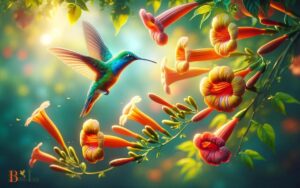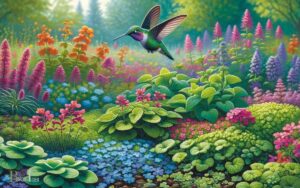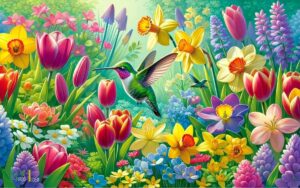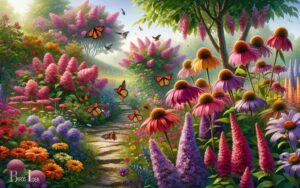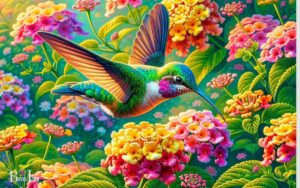Does Butterfly Weed Attract Hummingbirds? Yes!
Yes, butterfly weed (Asclepias tuberosa), a perennial plant native to North America, is known to attract hummingbirds.
The vibrant orange to yellow flowers produce nectar that is appealing to these small, nectar-feeding birds, alongside attracting butterflies and other pollinators.
Butterfly weed is a member of the milkweed family, and it’s recognized for its ability to attract a variety of wildlife, including hummingbirds.
The bright coloring of its flowers serves as a visual attractant, and the nectar provides a valuable food source for hummingbirds, who require high-energy sustenance to maintain their rapid wing flapping.
Butterfly weed typically blooms from early summer to early fall, which coincides with the time when hummingbirds are most active, especially during their migration periods.
Incorporating butterfly weed into your garden can create a lively and colorful atmosphere that not only beautifies the space but also supports the local hummingbird population.

Key Takeaway
Understanding Butterfly Weed
Butterfly weed, also known as Asclepias tuberosa, is a perennial plant native to North America. It is a member of the milkweed family and is well-known for its vibrant orange flowers.
This plant typically blooms from early summer to early fall and is commonly found in dry, sandy soils.
Butterfly weed is a vital plant for supporting the declining monarch butterfly population as it serves as a host plant for their larvae. Its nectar-rich flowers also attract various pollinators, including bees and butterflies.
Additionally, butterfly weed is known for its ability to thrive in hot and dry conditions, making it a popular choice for xeriscaping and drought-resistant gardening.
Understanding the characteristics of butterfly weed is essential in comprehending its role in attracting hummingbirds.
Characteristics of Hummingbirds
Characteristics of Hummingbirds are fascinating, especially in relation to their attraction to specific nectar-rich flowers like butterfly weed.
- High Metabolism: Hummingbirds have an incredibly fast metabolism, requiring them to consume large amounts of food, such as nectar, to sustain their energy levels.
- Hovering Ability: Their unique physical characteristics enable them to hover in mid-air, allowing them to feed from flowers by extending their long, specialized beaks into the blooms.
- Vibrant Plumage: Hummingbirds are known for their iridescent, vibrant plumage, which not only makes them beautiful to observe but also serves as a form of camouflage and can play a role in attracting potential mates.
Understanding these characteristics helps to appreciate why certain flowers, like butterfly weed, are particularly appealing to these remarkable creatures.
Importance of Pollinator Plants
Hummingbirds are highly dependent on pollinator plants for their nectar sources and play a crucial role in the pollination of these flowers.
As they feed on the nectar of various flowers, they inadvertently transfer pollen from one plant to another, aiding in the fertilization process.
Pollinator plants, therefore, serve as essential sources of food and sustenance for hummingbirds, allowing them to thrive and contribute to the ecosystem.
By supporting the growth and reproduction of these plants, hummingbirds help maintain biodiversity and the natural balance of their habitats.
Additionally, the presence of pollinator plants can enhance the beauty of gardens and landscapes, attracting not only hummingbirds but also other important pollinators such as bees and butterflies.
Overall, the presence of pollinator plants is vital for the well-being of hummingbirds and the ecosystems they inhabit.
Attracting Hummingbirds to Your Garden
Attracting hummingbirds to your garden can be a rewarding experience for any nature enthusiast.
Understanding the plants that attract hummingbirds, such as butterfly weed, can help create an environment that encourages these beautiful creatures to visit.
By incorporating the best plants for hummingbirds into your garden, you can enjoy the delightful presence of these tiny, vibrant birds.
Butterfly Weed and Hummingbirds
Butterfly Weed blooms from late spring to early fall, providing a food source that attracts hummingbirds to your garden.
The vibrant, nectar-filled flowers of Butterfly Weed are especially appealing to hummingbirds due to their high energy needs.
Here are three ways you can maximize the attraction of hummingbirds to your garden with Butterfly Weed:
- Planting Strategy: Place Butterfly Weed in areas of your garden that receive ample sunlight and provide easy visibility for hummingbirds.
- Companion Planting: Pair Butterfly Weed with other nectar-rich flowers to create a diverse and attractive feeding ground for hummingbirds.
- Maintenance: Regularly deadhead the flowers to encourage continuous blooming, ensuring a sustained food source for visiting hummingbirds.
Best Plants for Hummingbirds
A variety of nectar-rich flowers and plants can enhance the appeal of a garden to hummingbirds, providing them with diverse and plentiful food sources.
Some of the best plants for attracting hummingbirds include trumpet vine, bee balm, salvia, and cardinal flower.
These plants produce tubular flowers that are perfectly suited for the long, slender beaks of hummingbirds, allowing them to easily access the nectar within.
Additionally, incorporating native plants into the garden can be highly beneficial as they are well adapted to the local environment and are likely to attract native hummingbird species.
It’s also important to plant a variety of flowers that bloom at different times throughout the growing season, ensuring a constant supply of nectar for the hummingbirds.
By carefully selecting and maintaining these plants, gardeners can create a welcoming habitat that entices hummingbirds to visit and thrive.
Butterfly Weed and Hummingbird Behavior
Hummingbirds are known to exhibit distinct behavior patterns when interacting with the nectar of butterfly weed.
- They are attracted to the bright orange or red flowers of the butterfly weed, often hovering near the blooms while feeding on the nectar.
- Hummingbirds are known for their agility and speed, which allows them to dart quickly from flower to flower, making frequent visits to the butterfly weed throughout the day.
- Additionally, these tiny birds are known to be quite territorial and may fiercely defend a blooming butterfly weed plant from other hummingbirds.
Their behavior around butterfly weed showcases their remarkable ability to maneuver and their strong territorial instincts, making it a fascinating sight for nature enthusiasts.
Tips for Planting Butterfly Weed
When planting butterfly weed, it’s important to consider its benefits, such as attracting pollinators like hummingbirds and butterflies.
Additionally, understanding the soil and sunlight requirements for butterfly weed is crucial for its successful growth and blooming.
By following these tips, one can create an inviting environment for hummingbirds and other beneficial pollinators in their garden.
Butterfly Weed Benefits
Butterfly weed offers numerous benefits for gardeners looking to attract pollinators and add vibrant color to their landscapes.
Here are some key benefits of planting butterfly weed:
- Attracts Pollinators: Butterfly weed is a magnet for butterflies, bees, and other pollinators, making it an excellent addition to any pollinator garden.
- Low Maintenance: This native perennial is drought-tolerant, low maintenance, and resistant to pests and diseases, making it an easy-to-care-for plant.
- Vibrant Color: The plant’s bright orange or yellow flowers add a stunning pop of color to gardens, enhancing their visual appeal.
These benefits make butterfly weed an attractive choice for gardeners seeking to support pollinators and create visually appealing landscapes.
As for the requirements, let’s now delve into the soil and sunlight needs for successfully growing butterfly weed.
Soil and Sunlight Requirements
To successfully grow butterfly weed and attract hummingbirds, gardeners should ensure the plant is placed in well-drained soil and receives ample sunlight.
Butterfly weed, scientifically known as Asclepias tuberosa, thrives in dry to medium moisture, well-drained soils.
It is crucial to avoid waterlogged or overly wet soil, as this can lead to root rot. This plant is best suited for areas with full sunlight, as it requires at least six hours of direct sunlight per day to flourish.
When planting butterfly weed, it is recommended to choose a location with plenty of sunlight and soil that drains well, such as sandy or gravelly soils.
By meeting these soil and sunlight requirements, gardeners can provide an optimal environment for butterfly weed to attract hummingbirds and thrive in their gardens.
Attracting Pollinators With Butterfly Weed
Gardeners can enhance pollinator attraction by planting butterfly weed in well-drained, sunny areas. This vibrant perennial is a magnet for pollinators like butterflies, bees, and hummingbirds.
Here are three essential tips for successfully planting butterfly weed:
- Choose the Right Location: Butterfly weed thrives in full sunlight and well-drained soil. Ensure the planting area receives at least six to eight hours of direct sunlight daily and has soil with good drainage.
- Planting Technique: When planting butterfly weed, loosen the soil and add some organic matter to improve drainage. Plant the seeds or seedlings about 12-18 inches apart to allow for proper airflow and growth.
- Minimal Maintenance: Once established, butterfly weed requires minimal maintenance. Water the plants during dry spells and remove any weeds to ensure healthy growth and vibrant blooms.
Other Plants That Attract Hummingbirds
Attracting hummingbirds, many gardeners plant a variety of flowers known for their nectar-rich blooms.
Some popular choices include trumpet vine, bee balm, salvia, and penstemon, all of which have tubular flowers that are perfectly suited for hummingbirds’ long, slender bills.
- Trumpet vine, in particular, is a favorite of hummingbirds due to its vibrant red, orange, and yellow blossoms.
- Bee balm, with its showy, spiky flowers, is also a great addition to a hummingbird garden.
- Salvia, with its tall spikes of colorful flowers, and penstemon, with its graceful, tubular blooms, are both excellent choices for attracting these delightful birds.
By incorporating a variety of these nectar-rich plants into the garden, it’s possible to create an inviting habitat for hummingbirds.
Creating a Hummingbird-Friendly Garden
In cultivating a hummingbird-friendly garden, it is essential to incorporate a diverse array of nectar-rich plants, such as butterfly weed, to attract these delightful birds.
Hummingbirds are drawn to vibrant, tubular flowers that provide ample nectar, so including a variety of colors and shapes will entice them to visit your garden regularly.
Additionally, it is crucial to ensure continuous bloom throughout the seasons, as hummingbirds rely on a steady supply of nectar.
Providing perches, such as small branches or decorative stakes, allows these energetic birds to rest and observe their surroundings while guarding their territory.
Key Elements for Creating a Hummingbird-Friendly Garden:
- Plant a diverse array of nectar-rich flowers.
- Ensure continuous bloom throughout the seasons.
- Provide perches for resting and observation.
Conclusion
Planting butterfly weed in your garden is like rolling out the red carpet for hummingbirds. With its bright flowers and sweet nectar, it’s sure to attract these tiny, colorful visitors.
By creating a hummingbird-friendly garden with butterfly weed and other pollinator plants, you’ll be treating your garden to a lively, fluttering show that’s sure to delight both you and your feathered guests.
So go ahead, plant some butterfly weed and watch the magic unfold!

